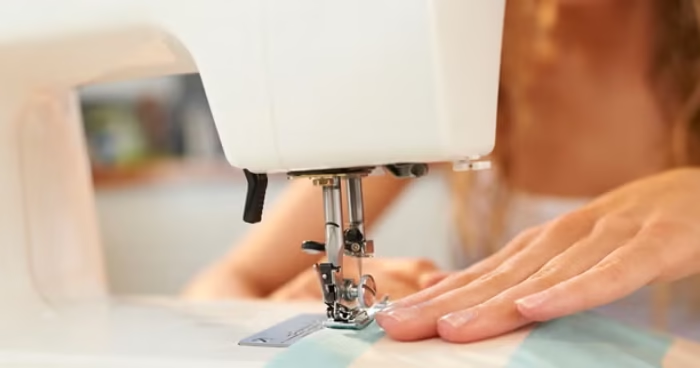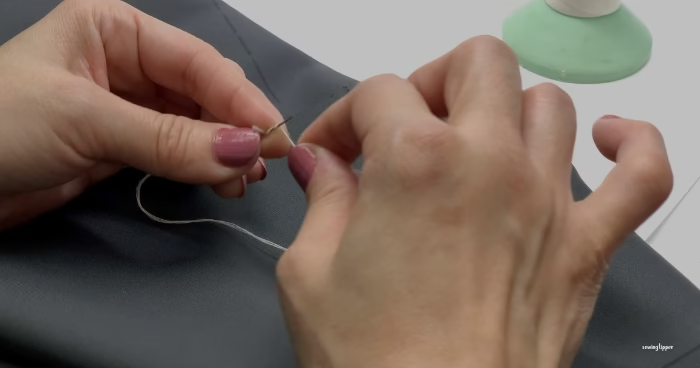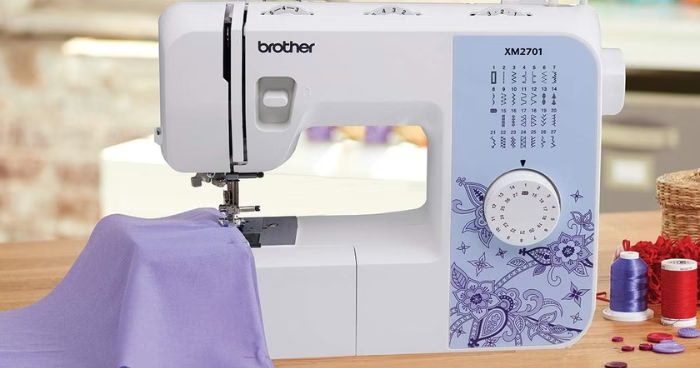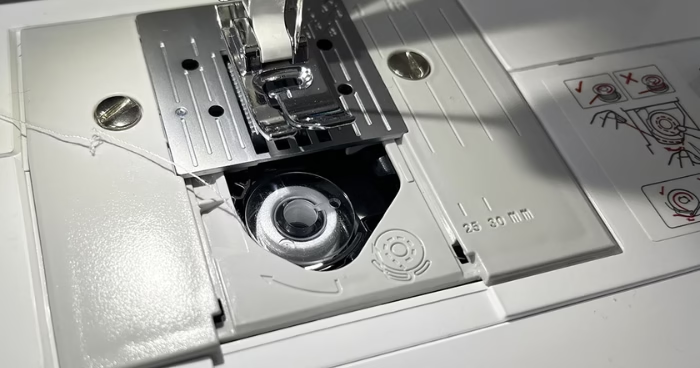How Does A Sewing Machine Work?
Have you ever wondered how does a sewing machine work? It’s just like setting up a game though. As the machines have their own unique ways to start up just like starting a game.
How Does A Sewing Machine Work?
However, dealing with a sewing machine is a little bit difficult at the beginning but don’t worry. Because we are here to make it super simple for you to understand the basics of sewing machine work.
Besides, if you want to make something incredibly cool or just wanna make flat stitches. You only need a few minutes to make sure everything is ready to go.
And to know the fun facts about sewing machines and how their parts do their job. Just consider this article as a thrilling journey to be a sewing expert which you can use to make awesome kinds of stuff!
Understanding Sewing Machine Working Mechanism:
To know about how a sewing machine works, you must delve into the fascinating world of its mechanism. It consists of 2 unique principles for making flawless stitching techniques.
Here are the 2 main principles:
1. Double Thread Stitch
A double-thread stitch is like teamwork in which two threads work together to make extra strong stitches. One thread comes from the top and the other from the bobbin below.
Both threads meet in the middle of the fabric to form a loop that locks everything tightly. It’s just like making a knot with your friend while holding hands.
Besides, double thread stitching is great for sewing things like patching a broken backpack strap or making sturdy seams on your favorite jeans. As they require extra strength, so this sort of stitching is excellent for these kinds of stuff.
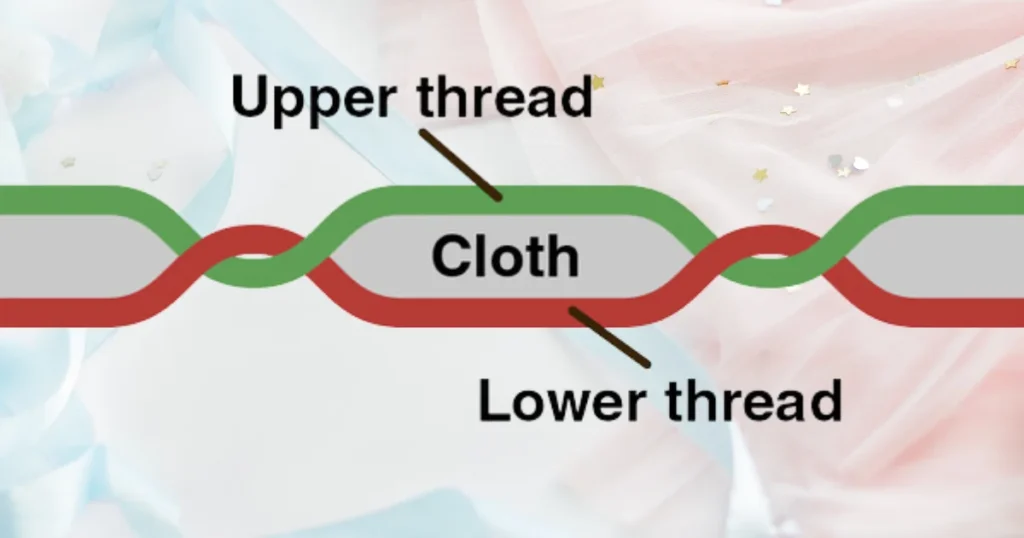
Mechanism of Double Thread Stitching
- Strongest stitch for seams: Using two threads, one from the upper spool and one from the lower bobbin is known as the strongest stitching.
- Meet in the middle: These two threads meet together in the center of the fabric while sewing the fabric.
- Making loops: When the needle passes through the material, it makes a loop by catching a thread from the bobbin below.
- Lock stitch sewing: These loops make a lock together to form a tight, secure and durable stitch.
- Extra security: Due to its strength and resilience, double-thread stitching is well-known for sewing jeans and bags.
- Prevents Unraveling: As there are two threads involved in it, if one breaks in the case, the other frequently holds the stitch together and prevents unraveling.
- Common in machines: Many sewing machines can make double-thread stitches, giving flexibility for various sewing needs.
- Decorative touch: Double thread stitch can give a decorative aspect to your sewing as they are often more apparent and pronounced.
- Needs Practice: The double-thread stitches might require a little bit more practice to master but it gives fantastic results once you get the hang of it.
Whether you are fixing a torn item or just starting a new project from scratch, understanding this sewing machine’s mechanics will help you create durable and long-lasting stitches.
READ ALSO: How to use a sewing machine step by step
Synchronize Stitch and Fabric Motion:
Synchronized stitching and fabric motion means making sure that how does stitching work with the fabric moves. The fabric is held together when the sewing machine makes stitches. If the stitching and fabric don’t work properly, you may experience issues like skipped stitches or unequal sewing.
However, modern sewing machines have settings to adjust the speed at which fabric moves and how the stitches look. By doing this correctly, you can ensure that your sewing looks strong and attractive.
Mechanism of Synchronized Stitch and Fabric Motion
- Basic knitting stitches: When you use a sewing machine, it creates knitting stitches by making loops in the fabric which holds the fabric and the stitches together.
- The fabric needs to move: The fabric must move when you start sewing. No movement of it can lead to various stitching problems.
- Modern machines have controls: You can make your stitches look tidy and fixed. Because modern machines have the power to control fabric and stitching speed.
- Setting changes: You have to adjust the sewing machine’s settings to get proper synchronization. For instance, for zig-zag stitches, you can change the length and width of the thread.
- Balancing appearance and strength: Getting the right synchronization not only ensures your stitches look good and even. But also it balances the appearance and strength of seams.
This sewing machine’s mechanics about synchronized stitching and fabric motion not only helps to make sure that stitches and fabric movement are working together properly. But it also helps in controlling issues like tension in the string and cloth bundling up repeatedly.
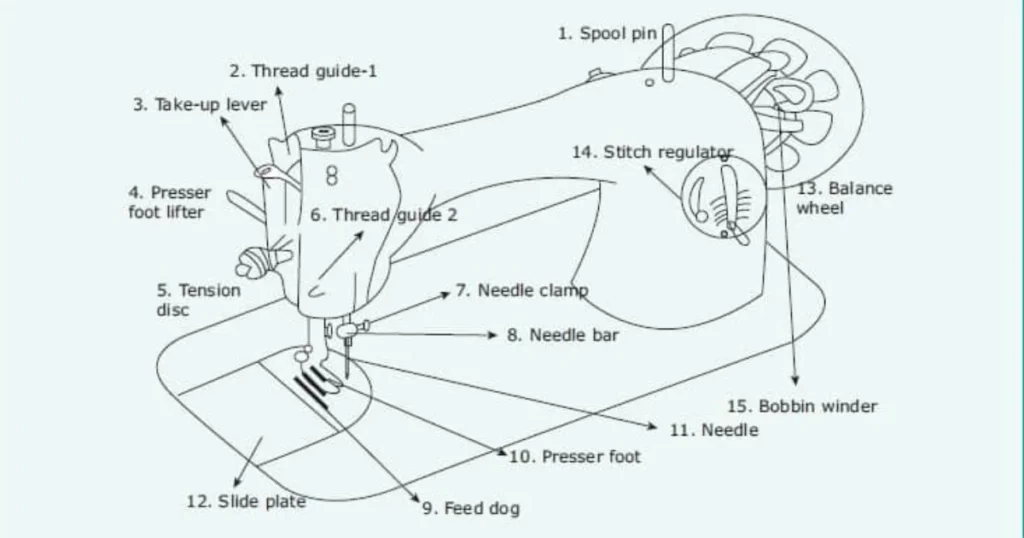
Sewing Machine Working: Detail Guide
To sew something, you use a “pedal” or button to start this sewing machine.
When this pedal is pressed, it tells the tiny “motor” (a small engine at the bottom) to start. Then, the motor moves a large round-shaped object on top called a “handwheel”. This wheel gently helps to sew the fabric gradually and carefully.
The “handwheel” is connected to an extended stick called a “power shaft” that passes through the sewing machine. This stick helps in making stitches. When you turn on the handwheel, the stick starts stitching the fabric which seems like magic!
Let’s explore these key parts separately that make this magic happen…
“Electric Motor”
Inside the machine, there’s a unique component located known as an electric motor. It functions as a mini engine that helps the machine to move. It is distant from the needle and sits at the bottom.
“Handwheel”
At the top of the machine, there’s a big spherical object called a handwheel which you can spin with your hand. When you start to rotate it, it helps the sewing machine(home appliance) sew gently and precisely.
“Power Shaft”
The part with which a handwheel is attached is known as a power shaft. It’s like a long stick that goes through the sewing operator. When the handwheel is rotated, it moves the power shaft to work more properly.
When these elements are used together to sew fabrics, it work magically. So, next time when you use a sewing machine, just keep these key elements in mind that make stitching so fascinating.
I am sure that after reading all these key points, you’ll be able to understand how a sewing machine works step by step.
How Does a Sewing Machine Stitch?
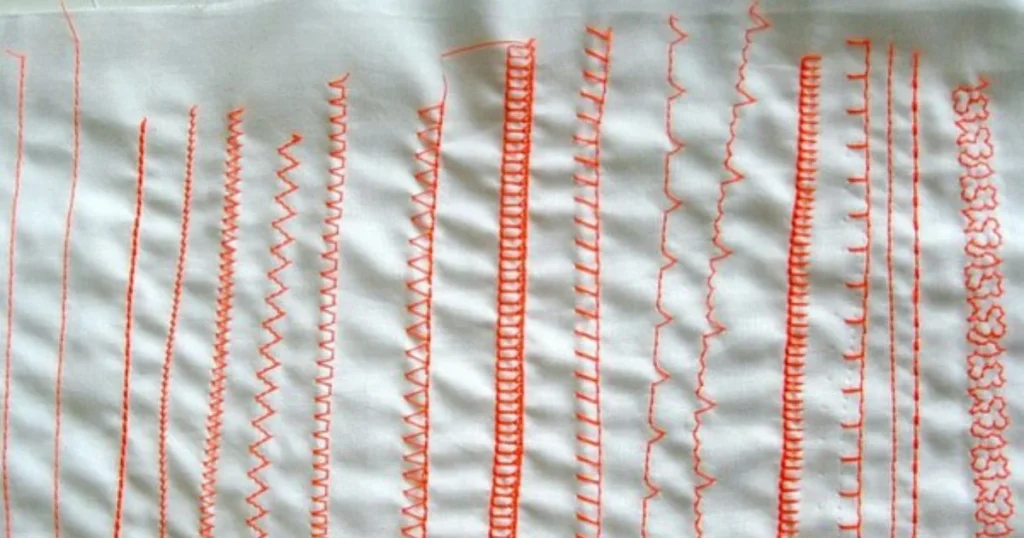
Have you ever wondered about how a sewing machine works to form stitches that hold the fabric together? Although the process might seem mysterious it’s quite interesting.
These 2 main processes are given below:
1. Stitch Formation
Sewing machines make stitches by using two threads; one from the top and the other underneath. The shuttle and the bobbin below periodically move as the needle goes up and down. When it goes down, it brings its thread together with a bobbin thread and forms a loop, like a hug between the threads. This loop makes a stitch that holds together very neatly.
2. Fabric Feeding
The sewing machine is a friendly guide for your fabric. When you start to sew, this machine moves the fabric very smoothly. Because the small teeth under the fabric called “Feed dogs” work like a machine’s hands.
These feed dogs gently grip the fabric and move it forward when you begin to sew. This teamwork ensures the fabric moves at the proper speed resulting in neat and even stitches.
This is how a sewing machine works to form stitches.
Basic Parts of a Sewing Machine:
A sewing machine is a special kind of machine that helps in sewing fabrics. It uses strong electric motors like the one that is used in vacuums also. This motor helps the needle to move up and down through the fabric to make neat stitches.
Let’s talk about some basic parts to understand how does a sewing machine work.
– Motor –
A “motor” is a tremendous part of a sewing machine. It helps the machine to do its job by making things move. By using a motor, you can complete your sewing tasks more easily and swiftly.
– Needle –
A “needle” is a tiny helper of a sewing machine that does a very big job. This pointy stick helps to make neat stitches in the fabric by moving up and down.
So, when you use a stitching machine, remember that this sewing needle is the one making the stitches that hold everything together.
– Feed Dog –
“Feed dog” works like a handy partner for textile machines. When you start sewing the material, it gently pushes the fabric to move ahead. Just like you’d guide your partner to walk beside you.
– Presser Foot –
A “presser foot” or sewing presser is a kind touch of a sewing machine. It helps keep your fabric in the correct place. By doing this, the material won’t move around unexpectedly and you can make your sewing patterns more easily.
– Stitch Adjuster –
The “stitch adjuster” is a unique button on a sewing stitch operator which performs a magical function. By pressing it, you can make your stitches longer and shorter, just like a magician changing the size of a rope.
– Thread Spool –
Imagine the “thread spool” as a thread feeder for your sewing home appliance. This spool provides threads like tiny strings. It helps to create different stitches on your fabric just like a spider uses its silk to create a web.
– Bobbin –
A “bobbin” is a secret thread keeper in your sewing projects. The thread spool manages the upper portion of your stitches while the bobbin takes care of the lower part. It’s like a base of a building, you can’t always see it but it’s always essential to keep it stable and sturdy.
– Tension Dial –
“Tension dial” is a friendly tightness-managing knob on your sewing machine. This dial helps in adjusting how tight or loose the threads are during stitching. It’s just like adjusting the strings of a guitar. When the tension dial is correct, it stitches more beautifully on your fabric.
– Foot Pedal –
“Foot Pedal” works like a sewing machine’s gas pedal equivalent to the car. When you press the pedal gently, it sews the fabric slowly. At the same time, when you press it more firmly, it makes the stitches faster. It’s like you can control the speed of sewing with your foot.
– Bobbin Winder-
A “bobbin winder” is a useful thread roller. It works like a tiny machine that fills up the bobbin by rolling thread into it, just like a yo-yo string. This way, you can make sure you have enough thread it needs to stitch things together.
These simple explanations will help you understand the basics of how sewing machine work.
Types of Stitches
For creating stitches that look the same in appearance and right in size. Here are some sewing machine stitches explained thoroughly.
– Chain Stitch –
A thread is looped around the sewing machine which passes through the fabric to form a stitch called “chain stitch”. A looper catches the thread before the needle comes out. As the needle lifts, the fabric starts to move forward.
After this, the next stitch wraps the thread through the previous one which forms a chain then. However, this stitch is speedy but not so strong, that’s why many machines use a stronger stitch instead.
– Lock Stitch –
“Lock stitch” is a common stitch made by many industrial and household sewing machines. It uses two threads; one from the needle and the other from the bobbin or shuttle below. While stitching, each thread stays on its side of the fabric and meets together at the holes that the needle makes.
However, this is only made possible with the help of a part called “bobbin driver”. And the unique thing about lockstitch is that it can be made anywhere on cloth, not just at the edges.
– Loop Stitch –
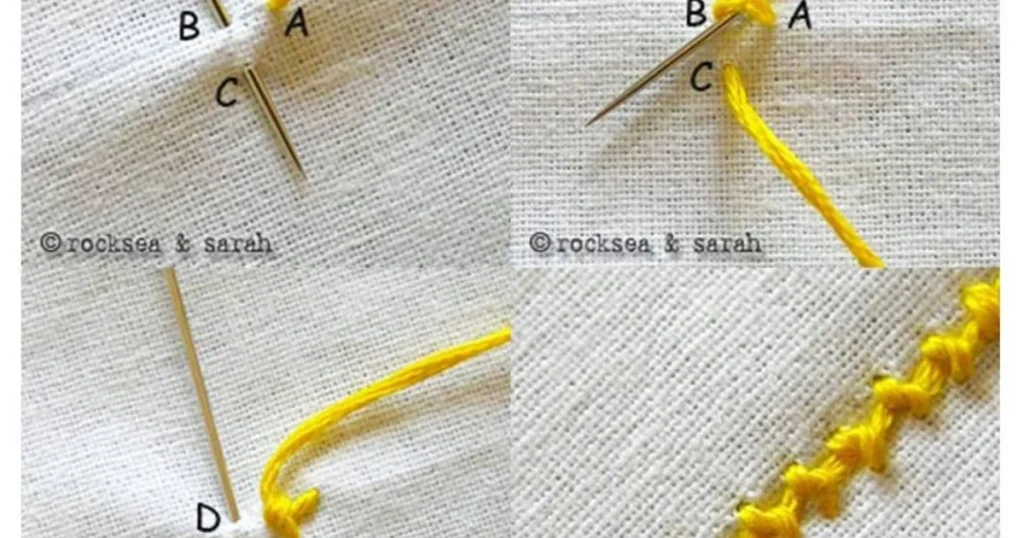
A “loop stitch” is a stitch that makes loops of thread on fabric. With a loop stitch, it makes a loop in the sewing machine through the fabric instead of going straight. It is what makes it different from normal stitches.
In this way, a sewing machine makes a line of loops by dragging a thread loop from one side of the fabric to the other. These sewing machine stitches work great for adding a decorative touch to your sewing projects.
– Cover Stitch –
“Cover stitch” is a unique stitching technique that is made with two or more needles or loopers. It can be made anywhere on fabric just like normal stitches. One looper drags a thread underneath the fabric to make a clean stitch underneath, and another looper on top makes a stitch on the top.
As a result, cross-hatched rows are formed. It’s called cover stitch because it covers the fabric edges very nicely just like the overlock stitch. This stitch is mostly used for sewing clothes to make seams look neatly and well-maintained.
– Zig Zag Stitch –
“Zig zag stitch” is actually a wavy version of normal sewing stitches. Instead of being straight, it moves forward and backwards. It is used when a straight stitch is insufficient. For instance, it stitches flexible textiles, stops fabric from splitting, and connects two layers side by side.
Plus, a zig-zag stitch is created with the help of a sewing machine part called a “cam”. When it is rotated, a finger-like thing attached to the needle bar follows its shape.
As a result, the needle moves left to right. However, ancient sewing machines can’t make zig-zag stitches. But, there are some attachments available to enable them to do it.
– Overlock or Serger Stitch –
A sewing technique known as “overlock” OR “serger stitch” is frequently used to make clothing. For making this stitch, specialized machines are used that sew and cut the fabric.
By using many threads and needles along with small sharp knives. It prevents the fabric from unraveling and messy.
Overlock stitches are perfect for those stretchy clothes and textiles that don’t need to be ironed. These stitches neaten the edges and can be of different varieties. Also, this “serger stitch” is an extraordinary stitch for making fabrics look extra nice!
FAQs:
Who invented the first sewing machine?
The first sewing machine was invented by a brilliant person named “Elias Howe”. He invented this machine in olden times to help people sew faster and better. His machine made stitching more easier by using a unique technique(the needle and thread).
Why was the sewing machine important?
The sewing machine made sewing easier for people working in business areas instead of just at home. This made sewing faster and cost less. Women who sew hard at home can now work in sewing factories to earn more money for their families.
How to use an old Singer sewing machine?
It’s simple to use an old Singer sewing machine. Just put your fabric underneath the needle, thread it, and then bring the needle down. Now start sewing by pressing the foot pedal and directing the fabric with your hands. When you’re done, lift the needle and take out the fabric.
What is computerized sewing machine embroidery?
When a sewing machine uses a computer to make attractive patterns on fabric, it is called computerized sewing machine embroidery. This machine follows the guidance from the computer to create pretty patterns by using various colored threads. It’s like magic stitches that make your fabric look elegant without using hands instead.
Conclusion:
Sewing machines are like smart friends that help your sewing more easier and faster. To make stitches that hold the fabric together, they use sharp components like motors, needles, and handwheels. Different stitches are available in this article from strong to decorative ones. You can make your sewing imaginative and fun.
And if in case you’ve got any kind of doubts, let us know in the comment section. Your feedback and queries are always welcome. Enjoy your sewing!
